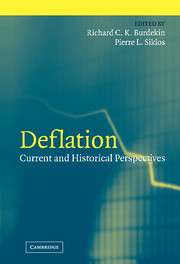Book contents
- Frontmatter
- Contents
- List of Tables and Figures
- List of Contributors
- Preface
- 1 Fears of Deflation and the Role of Monetary Policy: Some Lessons and an Overview
- PART ONE FEARS OF DEFLATION AND THE ROLE OF MONETARY POLICY
- PART TWO DEFLATION AND ASSET PRICES
- PART THREE INTERNATIONAL PERSPECTIVES ON DEFLATION
- PART FOUR STOCK MARKET ADJUSTMENTS TO DEFLATION
- 10 Deflation, the Financial Crises of the 1890s, and Stock Exchange Responses in London, New York, Paris, and Berlin
- 11 The Stock Market and the Business Cycle in Periods of Deflation, (Hyper-) Inflation, and Political Turmoil: Germany, 1913–1926
- 12 Deflationary Pressures and the Role of Gold Stocks: 1929, 1987, and Today
- References
- Index
- Titles in the series
12 - Deflationary Pressures and the Role of Gold Stocks: 1929, 1987, and Today
Published online by Cambridge University Press: 15 December 2009
- Frontmatter
- Contents
- List of Tables and Figures
- List of Contributors
- Preface
- 1 Fears of Deflation and the Role of Monetary Policy: Some Lessons and an Overview
- PART ONE FEARS OF DEFLATION AND THE ROLE OF MONETARY POLICY
- PART TWO DEFLATION AND ASSET PRICES
- PART THREE INTERNATIONAL PERSPECTIVES ON DEFLATION
- PART FOUR STOCK MARKET ADJUSTMENTS TO DEFLATION
- 10 Deflation, the Financial Crises of the 1890s, and Stock Exchange Responses in London, New York, Paris, and Berlin
- 11 The Stock Market and the Business Cycle in Periods of Deflation, (Hyper-) Inflation, and Political Turmoil: Germany, 1913–1926
- 12 Deflationary Pressures and the Role of Gold Stocks: 1929, 1987, and Today
- References
- Index
- Titles in the series
Summary
INTRODUCTION
After the U.S. stock market plunged in October 1929, deflation in asset prices was soon followed by declining goods prices as well. Although this episode has attracted enormous scrutiny over the years, surprisingly little attention has been paid to the fact that one of the very few, if not only, areas of appreciation during the bleak years after 1929 was in the stock prices of gold and silver producers. The largest gold producer at the time, Homestake Mining, enjoyed greater than 500 percent capital appreciation between October 1929 and December 1935, even as the Dow Jones index lost almost two-thirds of its value. These gains occurred in the midst of financial turmoil and massive bank failures, with nearly one-third of all U.S. banks failing between 1930 and 1933. At the same time, the great out-performance of gold stocks over this period proves that gold stocks do not require inflationary conditions in order to prosper. Indeed, the recent strength of gold stocks after 2000 has again occurred under conditions in which the threat of deflation again appears much more imminent than that of inflation – as reflected in the sharp rate cuts eventually taking the federal funds rate target down to 1 percent.
In this chapter, we assess the performance of gold stocks following two more recent stock market crashes (post–October 1987 and post–March 2000) in relation to the experience with Homestake Mining after the 1929 crash.
- Type
- Chapter
- Information
- DeflationCurrent and Historical Perspectives, pp. 318 - 330Publisher: Cambridge University PressPrint publication year: 2004
- 1
- Cited by



